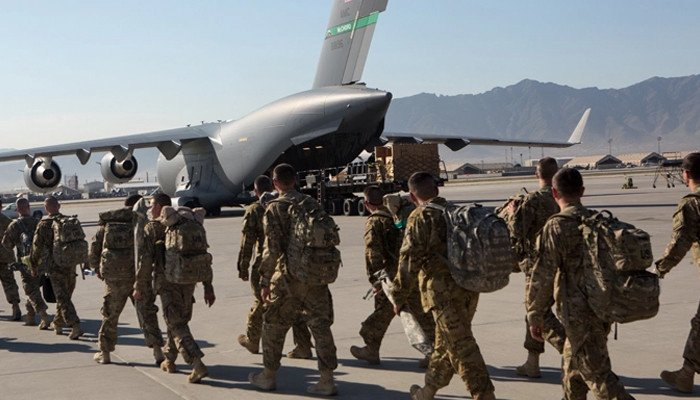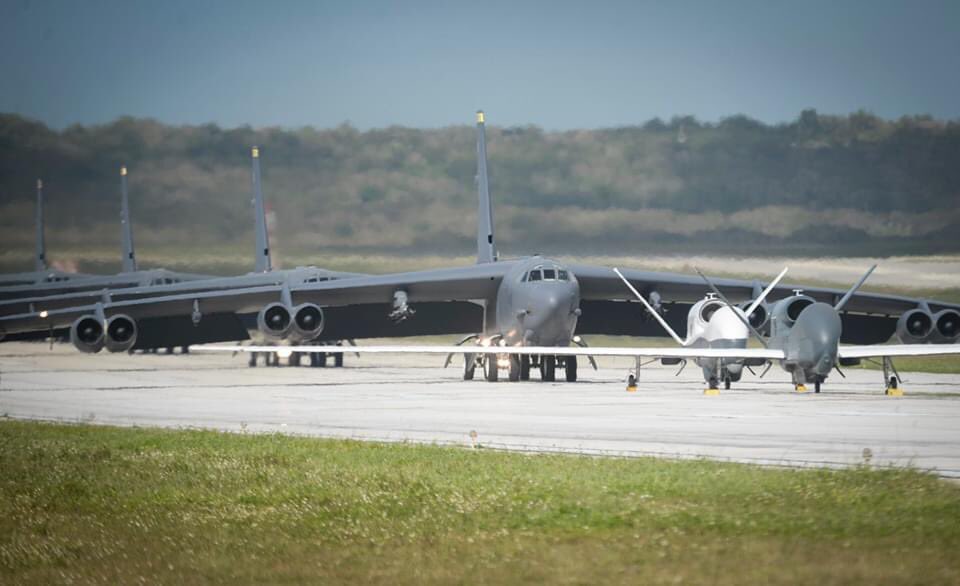The withdrawal of the remaining US military personnel from the Hamid Karzai International Airport, Kabul on August 31, 2021, officially marked the end of a two-decade-long American military intervention in Afghanistan.
20 Years Ahead Of Schedule, Why ‘Mighty’ Eurofighter Typhoons Are Being Retired By The Royal Air Force?
The Pentagon recorded that 800,000 American troops had served in its “war on terror” in Afghanistan. At the peak of US military operations in 2011, there were 100,000 American soldiers operating from 10 military bases, spanning from the Bagram airbase to Kandahar.
With the American strategic focus now being shifted towards the Indo-Pacific with the ‘aim to tame’ China, US armed forces are aggressively weaponizing the Asia-Pacific which is slowly becoming the global epicenter of the next big conflict.
The US military has historically remained an expeditionary force, which resulted in the setting up of overseas bases. According to David Vine, a professor of political anthropology at the American University, Washington DC, the US military operates over 750 overseas bases spread across 80 countries.
Compared to the US’ massive global military presence, China only operates one military base in Djibouti. The US Africa Commander believes that the Chinese naval base is large enough to support aircraft carriers, which has raised anxieties in Washington.
US President Joe Biden recently stated that US forces will continue to engage the enemy from “over the horizon” by carrying out airstrikes through America’s expansive network of military bases.

Japan, which neighbors China hosts the maximum number of US military bases/defense facilities. Over 53,000 US troops operate from 120 military bases in the Asian nation.
The island of Okinawa alone accounts for 62% of all US bases in Japan and covers 25% of the entire island. Futenma, Kadena, Hansen, Torii, Schwab, Foster, and Kinser are some major military bases on the island.
South Korea, another neighbor of China houses 73 US military bases with around 26,400 US soldiers and allied staff stationed there.
Some prominent American military facilities in South Korea are Camp Humphreys, located in Pyeongtaek, south of Seoul; Army Garrison Yongsan in central Seoul, Camp Walker in the southeastern city of Daegu, and two air bases in Osan and Gunsan, south of Seoul.
Germany hosts 119 US military bases, housing around 33,900 US troops. The iconic Ramstein Air Base in Rhineland-Palatinate, a state in southwestern Germany, is a particularly strategic American defense establishment in Germany.
This facility was reportedly used to carry out US drone strikes in Pakistan, Yemen, Afghanistan, and Somalia. US bases in Japan and South Korea may be of particular importance within Washington’s new strategic framework in the Indo-Pacific to contain Chinese expansion.
How US Military Bases Are Classified
Overseas US military bases are divided into two distinct categories: ‘Bases’ and ‘Lily Pads.’
‘Bases’ consist of military facilities which are over 10 acres in size or cost over $10 million, while ‘Lily Pads’ are establishments lower than these stipulated ranges.
Over 60% of America’s overseas military facilities are designated as ‘Bases’ and can house over 200 troops. The remaining number of these establishments are ‘Lily Pads.’

Both the US Military and the Central Intelligence Agency (CIA) are known to operate numerous covert facilities stretched along the Eastern Hemisphere.
Some of these countries have been identified as Pakistan, Iraq, Syria, Djibouti, Kuwait, Chad, Cameroon, Nigeria, Qatar, Saudi Arabia among others. These covert facilities are primarily used as drone bases, sometimes with special operations force (SOF) elements.
Some Of Major Foreign Bases Of The US
Anderson Air Force Base, Apra Harbor, Guam
The Air Force base is about 2,000 miles away from the Asian subcontinent. The airbase is geo-strategically located in Guam which allows American forces to be flexibly positioned in a way that they can be readily deployed whilst maintaining the element of surprise in the event of hostilities.
The Anderson airbase is one of the few American military facilities that have the prerequisite hangar facilities needed to shelter the B-2 stealth bomber without damaging the aircraft’s sensitive radar reflecting coating. The airbase hosts a wide array of strategic air assets ranging from drones to long-range strategic bombers
US strategic bombers are known to routinely carry out power projection missions from the Anderson airbase and transit in and around the facility regularly. The Apra Harbor can dock nuclear submarines and aircraft carriers to carry out maintenance.

Three Maritime Prepositioning Squadrons have also been established on this base, allowing for mobile, long-term storage of land-combat equipment and supplies near potential global hotspots.
Bezmer Air Base, Bulgaria
Bulgaria’s Bezmer Air Base is one of the more austere overseas bases operated by the US military. The primary aim of this airbase is to surge troops and material towards active frontlines. This was set up keeping conflicts in the Middle East and Central Asia in mind.
Cheaper real estate costs in Eastern Europe are a reason why the US chose Bulgaria. Furthermore, it is geographically closer to global hotspots.
This base maintains a significantly lower profile compared to other American overseas facilities in Western and Central Europe. The Pentagon has been incredibly reluctant to even refer to the facility in Bezmer as a “base” and insists that it is the host nation, which operates the establishment.
Diego Garcia, British Indian Ocean
Diego Garcia is a widely known American strategic facility. It is centrally located in the Indian Ocean and is often touted as one of the most secure defense establishments.
The US military used this strategically isolated base to oversee B-52 missions during Operation Desert Storm in 1991 and post 9/11 interventions in Iraq and Afghanistan. The US Army and Marine Corps prepositioning squadrons are stationed here to maintain land-combat equipment and supplies.
The base has specially designed shelters to ensure the safety of the stealth equipment housed within the facility. Low observable aircraft and strategic bombers regularly rotate in and out of the Diego Garcia and are indicative of how it may be operationally used.
The facility also houses some of the US Space Surveillance Network of telescopes, radars, and listening stations. This makes it a highly sensitive US military facility.
Guantánamo Bay, Cuba
Guantánamo Bay is one of America’s most controversial military facilities post 9/11. Nicknamed ‘Gitmo’, the facility was historically intended to serve as a Naval coaling station and continues to be used as a major logistical hub for US naval vessels deployed in the Caribbean Sea.
It also serves as a hub for anti-narcotics operations and migrant interdiction operations.

Gitmo’s judicial challenges arise from the fact that it is controlled by the US but is not housed on American soil. Adding to its notoriety are reports of the widespread use of “enhanced interrogation” techniques by CIA and military intelligence personnel to extract information from designated enemy combatants who were often held without due process.
While Gitmo is not the only facility where suspected “enemy combatants” have been held, what sets it apart from other detention facilities and ‘black sites’ is its proximity to the US mainland.
There have been repeated calls for the permanent closure of Gitmo since the 2000s, but successive US administrations have rejected such pleas. Now, the Biden administration has launched a review and has expressed its intention of shutting it down.
It may be interesting to point out that the trial of the alleged 9/11 mastermind Khalid Sheikh Mohammed and other key accused will take place inside Guantánamo Bay, under a military tribunal set up by a special military commission.
Thule Airbase, Greenland
Thule Airbase is located in Greenland and is America’s northernmost military facility in the world. The base is only 1,524km away from the North Pole and 1,207km north of the Arctic Circle.
Its primary users are the US Air Force (USAF) and the North American Aerospace Defense Command (NORAD).
Thule airbase was illegally set up during World War II to protect Danish colonies from the threat of Nazi occupation. It is currently used for defense and space monitoring purposes.
The airbase houses a network of sensors, which belong to the 21st Space Wing and enables it to provide space surveillance and control, and early missile warnings.
Why So Many Bases?
After the Cold War, the US did contemplate closing down overseas military bases, especially those located in Europe. The Clinton administration spearheaded some of the most significant overseas military base reductions.
Even the Bush administration closed down several hundred overseas bases. In 2012, the Obama administration recalled two army brigades from Germany, however, the decision was reversed following Russia’s annexation of Crimea.
The most recent development came from the Trump administration earlier this year in the form of the proposed withdrawal of 12,000 American military personnel from Germany. However, this move was blocked by the US Congress.
Now, with American troops gone from Afghanistan, it is speculated that the drive to curb the number of overseas military bases will continue.
General Mark Kelly, Chairman, Joint Chiefs of Staff, had recently said a “large permanent US bases overseas might be necessary for rotational forces to go into and out of but permanently positioning US forces I think needs a significant relook for the future”.
Some quarters within the US Department of Defence (DOD) are calling for a paradigm shift from maintaining permanent overseas bases designed for ‘force projection’ towards deploying troops in forward operational bases on a temporary basis.
- Aritra Banerjee is a defense journalist who has worked in both online and print media. He has laid an emphasis on issues related to military human resources, tactical psychology, military-media relations, professional military education, and combat fitness. He can be reached at aritrareporter@gmail.com.
- Follow EurAsian Times on Google News




